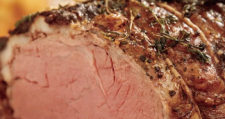What fun to be the lucky recipient of a food gift during the holidays: a ham on the front porch or nuts in the mail. Mail order food is a big business, with the majority of the industry’s sales occurring between Thanksgiving and Christmas. If you’re the recipient of such a gift, keep it safe by following a few simple rules of safe food handling.
“Although mail order food companies enjoy an excellent safety record, delays in mailing, breakage and failure of cold packing can occur,” said Londa Nwadike, assistant professor at Kansas State University. “That’s why it’s so important to inspect a food gift when it arrives to make sure it’s in good condition. Then handle it carefully to prevent spoilage and food poisoning.”
If the food item is marked “keep refrigerated,” open it immediately, and check that the temperature is below 40 degrees Fahrenheit by measuring it with a food thermometer. Ideally, the food should arrive frozen or partially frozen with ice crystals still visible.
Even if a meat product is smoked or cooked, it still requires refrigeration for safety, so it should be shipped with an ice source to keep it below 40 F, said Nwadike, who is a food safety specialist with K-State Research and Extension and the University of Missouri Extension.
If mail order food that should be frozen or refrigerated arrives above 40 F, contact the company, and follow its return policy. Do not consume or even taste it, as it may cause foodborne illness if eaten.
Some mail order foods, such as hard salami, don’t require refrigeration, as they’ve been cured, fermented and dried for weeks prior to shipping. They can be stored a few weeks at room temperature, as long as they are not labeled “keep refrigerated.”
Most semi-dry sausages require immediate refrigeration. To be on the safe side, check the label on all sausages upon delivery, and make sure they arrived at the recommended temperature.
Cheese, especially cheddar, is another popular gift item, as it travels well and shows little deterioration in cold weather. Soft cheeses, such as cream cheese, must arrive cold. Processed or hard cheeses can arrive at room temperature but should be refrigerated upon arrival.
If you receive more cheese than you can eat, freeze the surplus. Cut it into normal serving chunks, secure each individual piece tightly in plastic wrap, place the pieces in plastic bags and freeze. When ready to use it, take out only the amount you need, and place it in the refrigerator to defrost slowly for a couple of days.
Other popular food gifts include nuts, jams and jellies, all of which should be refrigerated after opening. You also can freeze nuts to prevent them from becoming dry or rancid.
“Remember, if perishable food arrives warm (above 40 F), spoiled or in questionable condition, don’t eat or even taste it,” Nwadike cautioned.
Contact the U.S. Food and Drug Administration food safety hotline at 888-723-3366 with general consumer food safety questions. For questions related to meat and poultry items, call the U.S. Department of Agriculture hotline at 888-674-6854, 9 a.m. to 3 p.m. CST on weekdays.

